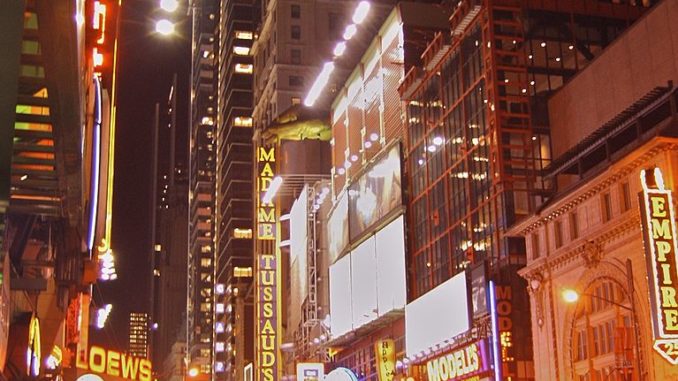
You are probably familiar with the phrase, Bright Lights, Big City, as it has been the title of a movie (1988), a book (1984), and a song (1961). Even before that it was a common idiom. When people said they were headed for “the bright lights”, they meant they were going to a big city to look for work, or sometimes specifically to Broadway or Hollywood in hopes of becoming a star.
Cities first became brightly lit places after the First World War, and neon lights were the technology that helped make it possible. (Well, that and electricity). Prior to neon, incandescent lights were the only choice there was if you wanted to light up with clean electricity instead of oil or gas. As fuels for illumination, neither oil nor gas burned cleanly and didn’t create much actual light relative to the new-fangled electric bulbs.
Thomas Edison made incandescent lighting commercially viable in 1879 with the first successful light bulb design. The main problem with the incandescent bulb was it’s inefficiency (which is why that technology is currently being replaced by LED lighting). Incandescent lights use a lot of electricity, a great deal of which is wasted in the form of heat energy. Ever touch a hot light bulb? That was wasted energy you felt – and I’m sure you will appreciate that fact more if it left a mark, or at least an impression on your memory. LED light is much more efficient, requiring a fraction of the electric power that an incandescent light requires. Yet, at higher wattage an LED light can still get very warm, if not hot, due to wasted heat energy. Thus, LEDs are much more efficient than incandescents, but still far from perfect.
Neon is a very efficient form of lighting. The average cost to run a neon sign for 24 hours a day is about 20 cents a day, or less than it costs you to run a 75 watt bulb. And because the sign doesn’t get hot, leaving it on is not a fire risk.
adeatersnyc.com
You cannot burn yourself on neon lighting. One of the wondrous things about it is it’s efficiency: it puts out a great deal of light, yet uses relatively little electricity. If you touch a lit neon tube, it won’t burn you. It doesn’t get hot due to the fact that very little heat energy is generated or lost.
In addition to efficiency and safety, another advantage of neon is it’s longevity. In downtown Los Angeles, a neon light was discovered behind a wall during building renovations in 2012. It is thought to have been there since 1935, when it was originally installed. The building owners believe it was accidently left on when it was covered over with a partition during a remodel some decades ago. They found it still working fine 77 years after it had first been turned on.
Frenchman Georges Claude was the first to successfully use a gas in a light tube and filed a patent in 1910. He used the chemical element neon, which makes an orangish-red light when excited by an electric current. Because neon was the first successful use of a gas in a tube to create light, all light tubes are called neon lights, regardless of the chemical ingredients inside the tube.
Different chemical elements are used to achieve different colors of light. In addition to the noble gases – neon, argon, krypton, xenon, helium, and radon – other elements and compounds are used in neon lighting including hydrogen, helium, carbon dioxide, and mercury. Each element or combination of elements gives off a different color when electricity is applied. The color can be further modified by adding phosphorus or fluorescent materials as coatings to the interior surface of the tube. Neon lights are available in more than 150 different colors today.
From the 1920s into the 1960’s, neon was extremely popular for signs and commercial lighting. People thought of neon lighting as futuristic. However, by the late sixties neon’s star began to fade, as it came to be seen as old fashioned. New plastic signs became popular and largely took neon’s place.
Perhaps because of the wave of nostalgia for the 1950s that our culture experienced in the 1970s (thank Fonzie and Happy Days), neon began a slow comeback in the late seventies that is still growing today. An appreciation for the art form and the power-saving efficiency of the technology also contribute to a renewed interest in neon lighting.
There are two entertaining and informative videos that I recommend:
How Neon Lights Work (2:08 minutes)
(Note that this video contains an error; they have the polarity of the cathode and anode reversed).
How Neon Signs Are Made (5:01 minutes)
(An excerpt from the Discovery Channel TV show, “How Its Made”).
Question of the night: What lights up your life? (besides old Debbie Boone songs, that is).
